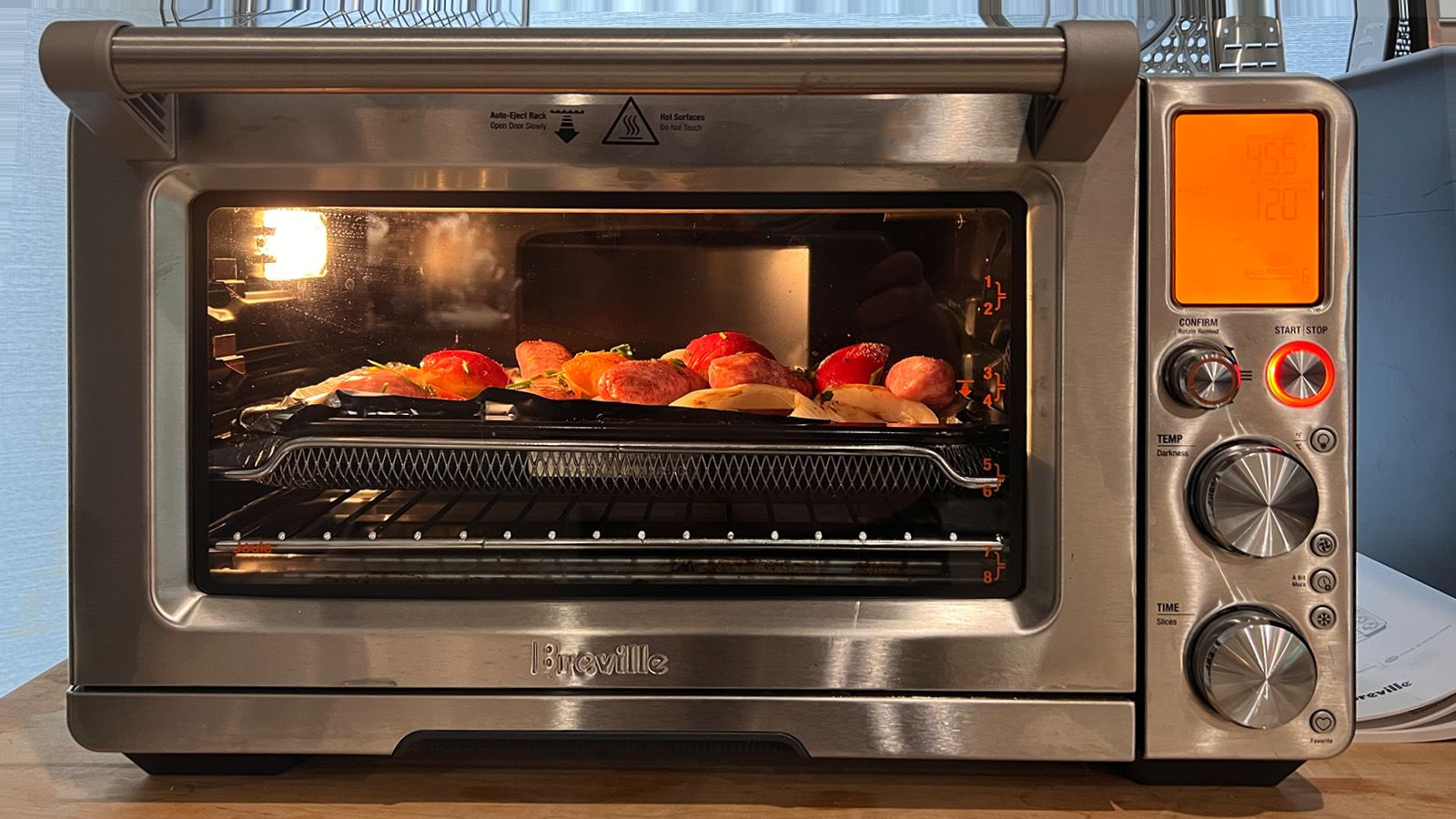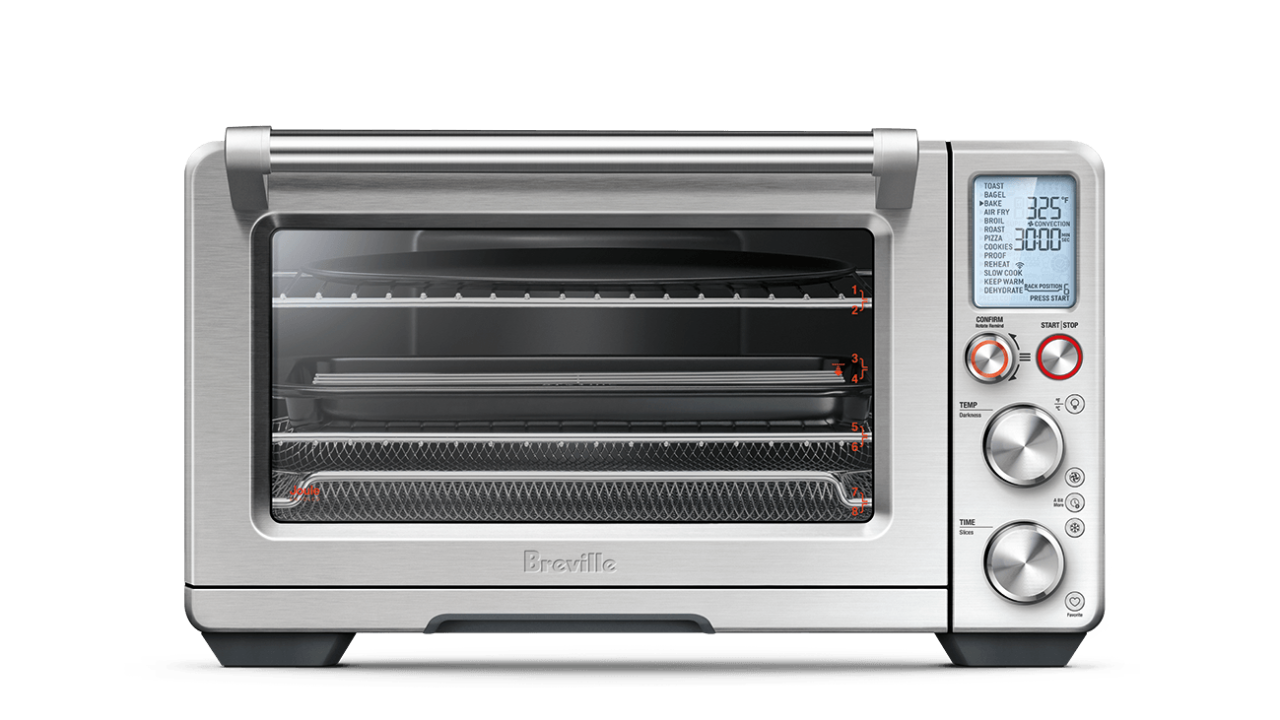In July 2019, high-end kitchen appliance brand Breville acquired ChefSteps, the company behind the popular Joule sous vide circulator. Breville has now released the first Joule product under its own name, the Breville Joule Oven Air Fryer Pro, which adds IoT functions and app control to the existing Breville Smart Oven lineup.
We spent several weeks using the Joule Oven and think that it can benefit home cooks who want a very simplified experience and are looking for automation features to direct and assist them as they try out new recipes or learn new cooking techniques. Experienced cooks looking for fine-grained control and customization in a quest to reproduce restaurant-grade results or prepare meals at a very high “food geek” level are likely to find the “smarts” too limited or simply unnecessary.
What we liked about the Joule Oven
Unpacked, the Breville Joule Oven closely resembles the Smart Oven Air Fryer Pro — available in brushed steel or black, the device is, as you’d expect, well built and nicely designed. It’s on the large side for a countertop oven at 21.5 inches by 17.3 inches by 12.8 inches and weighing in at 23 pounds.
Considered just as an oven, the Joule has many of the same advantages and drawbacks as its less expensive sibling. It’s bigger and has a higher capacity than the brand’s standard-size Smart Ovens (14 inches by 18.5 inches by 11 inches), so you can cook larger things in the oven cavity; it has more rack space (eight rack positions in all). So as a small convection oven, it works very well.
The front panel features simple knob controls for temperature, timing and mode selection, with an illuminated LCD for visual feedback. In addition to a “Start” button, there are also a few specialty small button studs for super-convection/convection on-off, cook-from-frozen, “Favorite” and “A Bit More,” which we’ll address later.
But if you relied only on the physical controls, you would be missing the point of the product: connectivity and programmability. The Joule Oven is connected (using Wi-Fi and Bluetooth), and the Joule Oven app for Android and iOS gives you access to?a variety of automated cooking and baking modes, including guided recipes that walk you through meal prep tasks.
Using the Joule Oven
The app, curated by Breville’s ChefSteps staff, gives you access to recipes across many categories. You can seach based on primary ingredients (Chicken, Seafood, Vegetables, etc.) or dietary requirements (Gluten-free, Vegetarian, Healthy), meal type (Breakfast, Dinner, Snack, etc.) or other terms. When a recipe is selected, such as “Set-it-and-forget-it Rotisserie-style Chicken,” the app shows you the ingredient list and required equipment (in this case the Broiling Rack and Roasting pan included with the oven).
Rather than simply adjusting the oven itself, the Joule Oven app guides you through all of the steps needed to produce the desired result and then prompts you to interact with the oven itself to start any cooking phases needed. In the case of the Rotisserie Chicken, the app instructs you to truss and season the chicken in two consecutive steps and then prompts you to start the roast phase. The app’s smarts then take over, simulating the browning effect of a rotisserie using an “Autopilot flight plan” in which the air is circulated using the convection function while the device cycles the main heat element and the top broiler.
This approach to programmed cooking is geared toward the novice who’s learning recipes and techniques rather that toward the experienced cook trying to hit exact protein temperatures.

The oven can cook with variable heat profiles using these automatic programs, from as low as 80 degrees Fahrenheit (for proofing dough) to as high as 480 degrees Fahrenheit. For other recipes, Autopilot flight plans vary oven temperature and convection (the oven’s PID control adjusts these parameters based on app settings)?and will alternate between heat element and broiler settings depending on the requirements of the dish.
We tried several app recipes, such as the Classic Beef Lasagne, and they worked out fine. However, it’s difficult to say whether it would have worked out any better than if we put the lasagna in the oven, manually set it to 350 degrees Fahrenheit, bake mode and returned in 40 minutes to check it.
As it turned out, the lasagna was slightly underdone at the first pass. So we pressed Breville’s specialized button labeled “A Bit More” (there’s one on the oven, and it’s also available in the app), which adds cook time at the end, proportionally adjusted to each recipe. In this case, it got us the appropriate amount of extra cooking time, and our lasagna was done. Possibly, this function is used to teach learning algorithms (or the human recipe authors at ChefSteps) to refine the recipes in the app; the company was not completely transparent as to how the system “learns” from use, but it did tell me that the recipes in the app are constantly being updated and refined from cooking activity.
ChefSteps tests all of the recipes to assure results. While a six-month subscription to ChefSteps’ Studio Pass premium content is included with the Joule Oven, after which you can sign up for $5.75 per month billed annually, this is just a bonus if you’re interested in extending your cooking knowledge. You don’t need the Studio Pass to use the oven, and all Joule-specific recipes available in the Joule app are free to use. The Pass simply adds a lot more recipes and covers a wider range of cooking techniques that you can apply elsewhere in the kitchen.
What we didn’t like about the Joule Oven
The Joule Oven’s smarts are fairly limited. Most significantly, the companion app doesn’t allow you to create your own recipes — you can create favorites within the app, but you can’t share these with others either directly or on social media (something the Anova Precision Smart Oven’s smart app allows). While we understand that Breville and ChefSteps are trying to deliver a tested experience for novice cooks, we found the app’s lack of basic functionality frustrating, missing recipe creation and customization, recipe sharing and cooking histories.
You can connect your device to Alexa or Google Assistant, but the functionality is minimal, such as asking for status updates and basic manual control, e.g., “Set the oven to bake at 350 degrees for 30 minutes.”
Given all of this, as seasoned cooks, we found ourselves skipping the app altogether and reaching for the manual controls instead — meaning experienced buyers might want to save some money and just opt for the $399.95 Smart Oven Air Fryer Pro instead.
We didn’t feel the additional functions offered enough usability. The air fryer in particular wasn’t nearly as effective in our tests as a dedicated air fryer (perhaps because of the larger chamber of the Joule; the more compact dedicated air fryer did a better job heating and convecting air around the food).
As a toaster, the Joule isn’t anywhere near as good as a smaller toaster oven (such as one of the smaller Smart Ovens) or a dedicated toaster. To get any browning on your toast, we had to set the toast setting to level 7 (meant for four slices), even if you are only toasting one slice of homemade sourdough. And even then sometimes we needed “A Bit More” to finish the job.
How it stacks up
The Joule Oven is Breville’s first attempt at making a truly connected Smart Oven, with features targeted more toward the home cook who wants to learn to cook more sophisticated meals but needs the extra guidance that recipe testing and app control bring to the table. And it does deliver for this type of cook.
We do think that it may disappoint those looking for more advanced functions or customizability. The Joule Oven lacks the steam and sous vide combi oven features and temperature probe-based functions that some of its smart oven rivals (such as the Anova Precision Oven) offer, limiting its usefulness for true precision cooking, which was surprising, given the Joule brand’s history in sous vide precision cooking.
Still, we are hopeful Breville will iterate on the idea and add functionality in subsequent Joule ovens. But for now we’d recommend this one mostly to beginners wanting a tool that amounts to a built-in cooking instructor.

















